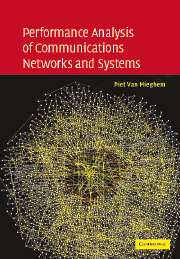Book contents
- Frontmatter
- Contents
- Preface
- 1 Introduction
- Part I Probability theory
- Part II Stochastic processes
- Part III Physics of networks
- 15 General characteristics of graphs
- 16 The Shortest Path Problem
- 17 The effciency of multicast
- 18 The hopcount to an anycast group
- Appendix A Stochastic matrices
- Appendix B Algebraic graph theory
- Appendix C Solutions of problems
- Bibliography
- Index
15 - General characteristics of graphs
from Part III - Physics of networks
Published online by Cambridge University Press: 22 February 2010
- Frontmatter
- Contents
- Preface
- 1 Introduction
- Part I Probability theory
- Part II Stochastic processes
- Part III Physics of networks
- 15 General characteristics of graphs
- 16 The Shortest Path Problem
- 17 The effciency of multicast
- 18 The hopcount to an anycast group
- Appendix A Stochastic matrices
- Appendix B Algebraic graph theory
- Appendix C Solutions of problems
- Bibliography
- Index
Summary
The structure or interconnection pattern of a network can be represented by a graph. Properties of the graph of a network often relate to performance measures or specific characteristics of that network. For example, routing is an essential functionality in many networks. The computational complexity of shortest path routing depends on the hopcount in the underlying graph. This chapter mainly focuses on general properties of graphs that are of interest to Internet modeling.
Mainly driven by the Internet, a large impetus from different fields in science makes the understanding of the growth and the structure of graphs one of the currently most studied and exciting research areas. The recent books by Barabasi (2002) and Dorogovtsev and Mendes (2003) nicely reflect the current state of the art in stochastic graph theory and its applications to, for example, the Internet, the World Wide Web, and social and biological networks.
Introduction
Network topologies as drawn in Fig. 15.1 are examples of graphs. A graph G is a data structure consisting of a set of V vertices connected by a set of E edges. In stochastic graph theory and communications networking, the vertices and edges are called nodes and links, respectively. In order to differentiate between the expectation operator E[·], the set of links is denoted by L and the number of links by L and similarly, the set of nodes by N and number of nodes by N. Thus, the usual notation of a graph G(V, E) in graph theory is here denoted by G (N, L).
Information
- Type
- Chapter
- Information
- Performance Analysis of Communications Networks and Systems , pp. 319 - 346Publisher: Cambridge University PressPrint publication year: 2006
